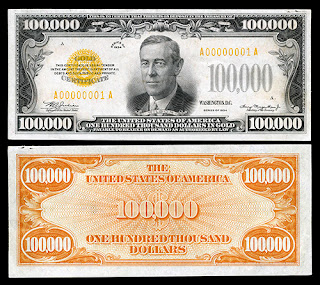 |
| President Wilson appeared on the $100,000 gold certificate |
Following my posting of the first two blogs about American currency, a reader commented that she saw no need to alter the image on the current $10 bill, and she challenged me to provide information about the expense of changing existing currency. (As an aside, it has been interesting to me that the comments opposing the proposed changes to the $10 bill have come from women, and none of the comments have been particularly supportive of the need to put a woman's image on our currency.) Because of the challenge to provide information about the cost of changing the image, I have done further research.
At http://papermoneyguide.com I learned that in 1996 the Bureau of Engraving and Printing changed our currency to make counterfeiting more difficult by imbedding polyester thread and microprinting around the portraits. This was done to defeat the use of copying machines by counterfeiters. That website predicted that suggestions to change the images on paper currency were unlikely to be implemented because of the expense of "several hundred thousand dollars for the necessary additional printing and processing equipment." Further, there would be costs of preparing new printing plates for both sides of the bills. Yet, it seems that changing the $10 bill is under consideration.
 |
| Portraits are not the only images to have appeared. |
It is the Secretary of the Treasury that usually selects the designs, unless specified by an Act of Congress, that decision being made with the advice of the Bureau of Engraving and Printing and the Commission of Fine Arts. Historically, the older design in circulation has not been recalled when new currency is issued, so if the image of Alexander Hamilton is replaced with a woman's image on the new $10 bills, Hamilton's image will continue in circulation on the old bills for years to come.
Except for the modification to protect against counterfeiting, the fronts and backs of our current currency have remained basically the same since 1928. The law prevents living persons from appearing on government securities, and the tradition has been to depict noteworthy persons and events, generally political figures. Today those are Washington ($1), Jefferson ($2), Lincoln ($5), Hamilton ($10) Jackson ($20), Grant ($50), and Franklin ($100). In 1969 production officially ended on the $500, $1,000, $5,000, $10,000, and $100,000 bills, on which McKinley, Cleveland, Madison, Chase, and Wilson appeared (listed in ascending order); however, printing of high denomination bills ended at the close of 1945.
 |
| Symbolic images of women have appeared |
The termination of printing high denomination bills was motivated by such considerations as risks from counterfeiting, and use in the illegal drug trade and money laundering, but electronic money transactions by banks and the Federal Government also made such large denominations unnecessary. As you might suspect, rarity has made these bills very collectible, and valuable. Gamblers in Las Vegas, Nevada once saw a display of one hundred $10,000 bills at Binion's Horseshoe Casino, but the display was eventually dismantled and the bills were sold to collectors.
 |
| Robert Morris, Revolutionary War financier |
Some high denomination notes were redeemed, some are in institutional collections, and some are in private collections. By executive order of President Richard Nixon, the Federal Reserve began taking high denomination bills out of circulation in 1969, and four decades later only 336 $10,000 bills, 342 $5,000 bills, and 165,372 $1,000 were known to exist.
As Treasury Secretary Jacob J. Lew considers whether to replace the image of Hamilton on the $10 bill with the image of a woman, he must evaluate breaking with precedent, expending a significant amount more than would be spent without the change, and satisfying one group while angering another.
(Robert Morris is a little known hero of the Revolution as a result of using his own wealth to repay debts incurred by the fledgling government. Lady Liberty, as well as female depictions of Justice and Victory have appeared. Treasury Secretary William Marcy appears with Lady Liberty above.)
2 comments:
Those are some huge bills. There are circulating on the net somewhere pictures of various denominations of the Euro with pictures of women on them. Do NOT Google. But in that vein, how about Kim Kardashian?
No living figures can appear on US currency...which, of course, also eliminates Paris Hilton, an earlier contender...
Post a Comment